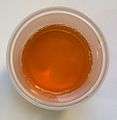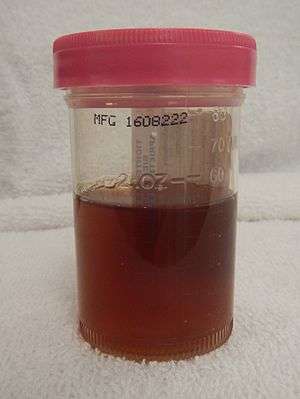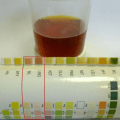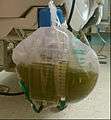Urine
Urine is a liquid by-product of metabolism in humans and in many other animals. Urine flows from the kidneys through the ureters to the urinary bladder. Urination results in urine being excreted from the body through the urethra.
Cellular metabolism generates many by-products that are rich in nitrogen and must be cleared from the bloodstream, such as urea, uric acid, and creatinine. These by-products are expelled from the body during urination, which is the primary method for excreting water-soluble chemicals from the body. A urinalysis can detect nitrogenous wastes of the mammalian body.
Urine has a role in the earth's nitrogen cycle. In balanced ecosystems, urine fertilizes the soil and thus helps plants to grow. Therefore, urine can be used as a fertilizer. Some animals use it to mark their territories. Historically, aged or fermented urine (known as lant) was also used for gunpowder production, household cleaning, tanning of leather and dyeing of textiles.
Human urine and feces are collectively referred to as human waste or human excreta, and are managed via sanitation systems. Livestock urine and feces also require proper management if the livestock population density is high.
Physiology
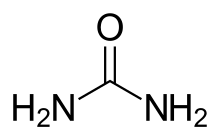
Most animals have excretory systems for elimination of soluble toxic wastes. In humans, soluble wastes are excreted primarily by the urinary system and, to a lesser extent in terms of urea, removed by perspiration.[1] The urinary system consists of the kidneys, ureters, urinary bladder, and urethra. The system produces urine by a process of filtration, reabsorption, and tubular secretion. The kidneys extract the soluble wastes from the bloodstream, as well as excess water, sugars, and a variety of other compounds. The resulting urine contains high concentrations of urea and other substances, including toxins. Urine flows from the kidneys through the ureter, bladder, and finally the urethra before passing from the body.
Characteristics
Quantity
Average urine production in adult humans is around 1.4 L of urine per person per day with a normal range of 0.6 to 2.6 L per person per day, produced in around 6 to 8 urinations per day depending on state of hydration, activity level, environmental factors, weight, and the individual's health.[3] Producing too much or too little urine needs medical attention. Polyuria is a condition of excessive production of urine (> 2.5 L/day), oliguria when < 400 mL are produced, and anuria being < 100 mL per day.
Constituents
About 91-96% of urine consists of water.[3] Urine also contains an assortment of inorganic salts and organic compounds, including proteins, hormones, and a wide range of metabolites, varying by what is introduced into the body.
The total solids in urine are on average 59 g per person per day. Organic matter makes up between 65% and 85% of urine dry solids, with volatile solids comprising 75–85% of total solids. Urea is the largest constituent of the solids, constituting more than 50% of the total. On an elemental level, human urine contains 6.87 g/L carbon, 8.12 g/L nitrogen, 8.25 g/L oxygen, and 1.51 g/L hydrogen. The exact proportions vary with individuals and with factors such as diet and health.[3] In healthy persons, urine contains very little protein and an excess is suggestive of illness.
Color

Urine varies in appearance, depending principally upon a body's level of hydration, as well as other factors. Normal urine is a transparent solution ranging from colorless to amber but is usually a pale yellow. In the urine of a healthy individual, the color comes primarily from the presence of urobilin. Urobilin is a final waste product resulting from the breakdown of heme from hemoglobin during the destruction of aging blood cells.
Colorless urine indicates over-hydration, generally preferable to dehydration (though it can remove essential salts from the body). Colorless urine in drug tests can suggest an attempt to avoid detection of illicit drugs in the bloodstream through over-hydration.
- Dark yellow urine is often indicative of dehydration.
- Yellowing/light orange may be caused by removal of excess B vitamins from the bloodstream.
- Certain medications such as rifampin and phenazopyridine can cause orange urine.
- Bloody urine is termed hematuria, a symptom of a wide variety of medical conditions.
- Dark orange to brown urine can be a symptom of jaundice, rhabdomyolysis, or Gilbert's syndrome.
- Black or dark-colored urine is referred to as melanuria and may be caused by a melanoma or non-melanin acute intermittent porphyria.
- Pinkish urine can result from the consumption of beets.
- Greenish urine can result from the consumption of asparagus or foods or beverages with green dyes.
- Reddish or brown urine may be caused by porphyria (not to be confused with the harmless, temporary pink or reddish tint caused by beeturia).
- Blue urine can be caused by the ingestion of methylene blue (e.g., in medications) or foods or beverages with blue dyes.
- Blue urine stains can be caused by blue diaper syndrome.
- Purple urine may be due to purple urine bag syndrome.
Odor
Sometime after leaving the body, urine may acquire a strong "fish-like" odor because of contamination with bacteria that break down urea into ammonia. This odor is not present in fresh urine of healthy individuals; its presence may be a sign of a urinary tract infection.
The odor of normal human urine can reflect what has been consumed or specific diseases. For example, an individual with diabetes mellitus may present a sweetened urine odor. This can be due to kidney diseases as well, such as kidney stones.
Eating asparagus can cause a strong odor reminiscent of the vegetable caused by the body's breakdown of asparagusic acid.[4] Likewise consumption of saffron, alcohol, coffee, tuna fish, and onion can result in telltale scents. Particularly spicy foods can have a similar effect, as their compounds pass through the kidneys without being fully broken down before exiting the body.[5][6]
Turbidity
Turbid (cloudy) urine may be a symptom of a bacterial infection, but can also be caused by crystallization of salts such as calcium phosphate.
pH
The pH normally is within the range of 5.5 to 7 with an average of 6.2.[3] In persons with hyperuricosuria, acidic urine can contribute to the formation of stones of uric acid in the kidneys, ureters, or bladder.[7] Urine pH can be monitored by a physician[8] or at home.
A diet which is high in protein from meat and dairy, as well as alcohol consumption can reduce urine pH, whilst potassium and organic acids, such as from diets high in fruit and vegetables, can increase the pH and make it more alkaline.[3] Some drugs also can increase urine pH, including acetazolamide, potassium citrate, and sodium bicarbonate.
Cranberries, popularly thought to decrease the pH of urine, have actually been shown not to acidify urine.[9] Drugs that can decrease urine pH include ammonium chloride, chlorothiazide diuretics, and methenamine mandelate.[10][11]
Density
Human urine has a specific gravity of 1.003–1.035.[3] Any deviations may be associated with urinary disorders.
Hazards
Healthy urine is not toxic.[12] However, it contains compounds eliminated by the body as undesirable, and can be irritating to skin and eyes. With suitable processing, it is possible to extract potable water from urine.
Bacteria and pathogens
Urine is not sterile, not even in the bladder.[13][14] Earlier studies, with less sophisticated analytical techniques, had found that urine was sterile until it reached the urethra. In the urethra, epithelial cells lining the urethra are colonized by facultatively anaerobic Gram-negative rod and cocci bacteria.[15]
Examination for medical purposes

Many physicians in ancient history resorted to the inspection and examination of the urine of their patients. Hermogenes wrote about the color and other attributes of urine as indicators of certain diseases. Abdul Malik Ibn Habib of Andalusia d.862 AD, mentions numerous reports of urine examination throughout the Umayyad empire.[16] Diabetes mellitus got its name because the urine is plentiful and sweet. The name uroscopy refers to any visual examination of the urine, including microscopy, although it often refers to the aforementioned prescientific or protoscientific forms of urine examination. Clinical urine tests today duly note the gross color, turbidity, and odor of urine but also include urinalysis, which chemically analyzes the urine and quantifies its constituents. A culture of the urine is performed when a urinary tract infection is suspected, as bacteria in the urine are unusual otherwise. A microscopic examination of the urine may be helpful to identify organic or inorganic substrates and help in the diagnosis.
The color and volume of urine can be reliable indicators of hydration level. Clear and copious urine is generally a sign of adequate hydration. Dark urine is a sign of dehydration. The exception occurs when diuretics are consumed, in which case urine can be clear and copious and the person still be dehydrated.
Uses
.jpg)
Source of medications
Urine contains proteins and other substances that are useful for medical therapy and are ingredients in many prescription drugs (e.g., Ureacin, Urecholine, Urowave). Urine from postmenopausal women is rich in gonadotropins that can yield follicle stimulating hormone and luteinizing hormone for fertility therapy.[17] One such commercial product is Pergonal.[18]
Urine from pregnant women contains enough human chorionic gonadotropins for commercial extraction and purification to produce hCG medication. Pregnant mare urine is the source of estrogens, namely Premarin.[17] Urine also contains antibodies, which can be used in diagnostic antibody tests for a range of pathogens, including HIV-1.[19]
_(2957323941).jpg)
_(2957323823).jpg)
Urine can also be used to produce urokinase, which is used clinically as a thrombolytic agent.
Fertilizer
Urine contains large quantities of nitrogen (mostly as urea), as well as reasonable quantities of dissolved potassium. The exact composition of nutrients in urine varies with diet, in particular nitrogen content in urine is related to the quantity of protein in the diet. A high protein diet results in high urea levels in urine.
Urine is very high in nitrogen (can be over 10% in a high-protein diet), low in phosphorus (1%), and moderate in potassium (2-3%). Urine typically contributes 70% of the nitrogen and more than half of the potassium found in urban wastewater flows, while making up less than 1% of the overall volume. If urine is to be separated and collected for use as a fertiliser in agriculture, then the easiest method of doing so is with sanitation systems that utilise waterless urinals, urine-diverting dry toilets (UDDTs) or urine diversion flush toilets.[20]
Undiluted urine can chemically burn the leaves or roots of some plants, particularly if the soil moisture content is low, therefore it is usually applied diluted with water.
When diluted with water (at a 1:5 ratio for container-grown annual crops with fresh growing medium each season or a 1:8 ratio for more general use), it can be applied directly to soil as a fertilizer.[21][22] The fertilization effect of urine has been found to be comparable to that of commercial nitrogen fertilizers.[23] Concentrations of heavy metals such as lead, mercury, and cadmium, commonly found in sewage sludge, are much lower in urine.[24]
Urine can also be used safely as a source of nitrogen in carbon-rich compost.[22] The health risks of using urine as a natural source of agricultural fertilizer are generally regarded as negligible, especially when dispersed in the soil rather than on the part of the plant that is consumed. Urine can even be distributed via perforated hoses buried some 10 cm under the surface of the soil among our crop plants, thus minimizing risk of odors, loss of nutrients, or transmission of pathogens.[25]
Cleaning
Given that the urea in urine breaks down into ammonia, urine has been used for cleaning. In pre-industrial times, urine was used – in the form of lant or aged urine – as a cleaning fluid.[26] Urine was also used for whitening teeth in Ancient Rome.
Gunpowder
Urine was used before the development of a chemical industry in the manufacture of gunpowder. Urine, a nitrogen source, was used to moisten straw or other organic material, which was kept moist and allowed to rot for several months to over a year. The resulting salts were washed from the heap with water, which was evaporated to allow collection of crude saltpeter crystals, that were usually refined before being used in making gunpowder.[27]
Survival uses
The US Army Field Manual[28] advises against drinking urine for survival. These guides explain that drinking urine tends to worsen rather than relieve dehydration due to the salts in it, and that urine should not be consumed in a survival situation, even when there is no other fluid available. In hot weather survival situations, where other sources of water are not available, soaking cloth (a shirt for example) in urine and putting it on the head can help cool the body.
During World War I, Germans experimented with numerous poisonous gases as weapons. After the first German chlorine gas attacks, Allied troops were supplied with masks of cotton pads that had been soaked in urine. It was believed that the ammonia in the pad neutralized the chlorine. These pads were held over the face until the soldiers could escape from the poisonous fumes, although it is now known that chlorine gas reacts with urine to produce toxic fumes (see chlorine and use of poison gas in World War I). The Vickers machine gun, used by the British Army during World War I, required water for cooling when fired so soldiers would resort to urine if water was unavailable.[29]
Urban legend states that urine works well against jellyfish stings. This scenario has appeared many times in popular culture including in the Friends episode "The One With the Jellyfish", an early episode of Survivor, as well as the films The Real Cancun (2003), The Heartbreak Kid (2007) and The Paperboy (2012). However, at best it is ineffective, and in some cases this treatment may make the injury worse.[30][31][32]
Textiles
Urine has often been used as a mordant to help prepare textiles, especially wool, for dyeing. In the Scottish Highlands and Hebrides, the process of "waulking" (fulling) woven wool is preceded by soaking in urine, preferably infantile.[33]
History
Ancient Romans used fermented human urine (in the form of lant) to cleanse grease stains from clothing.[34] The emperor Nero instituted a tax (Latin: vectigal urinae) on the urine industry, continued by his successor, Vespasian. The Latin saying Pecunia non olet (money doesn't smell) is attributed to Vespasian – said to have been his reply to a complaint from his son about the unpleasant nature of the tax. Vespasian's name is still attached to public urinals in France (vespasiennes), Italy (vespasiani), and Romania (vespasiene).
Alchemists spent much time trying to extract gold from urine, which led to discoveries such as white phosphorus by German alchemist Hennig Brand when distilling fermented urine in 1669. In 1773 the French chemist Hilaire Rouelle discovered the organic compound urea by boiling urine dry.
Society and culture
Language
The English word urine (/ˈjuːrɪn/, /ˈjɜːrɪn/) comes from the Latin urina (-ae, f.), which is cognate with ancient words in various Indo-European languages that concern water, liquid, diving, rain, and urination. The onomatopoetic term piss was the usual word for urination before the 14th century and is now considered vulgar. Urinate was at first used mostly in medical contexts. Piss is also used in such colloquialisms as to piss off, piss poor, and the slang expression pissing down to mean heavy rain. Euphemisms and expressions used between parents and children (such as wee, pee, and many others) have long existed.
Lant is a word for aged urine, originating from the Old English word hland referring to urine in general.
See also
- Drinking urine (urophagia)
- Ureotelic
- Urine therapy
- Urolagnia, an attraction to urine
References
- Arthur C. Guyton; John Edward Hall (2006). "25". Textbook of medical physiology (11 ed.). Elsevier Saunders. ISBN 978-0-8089-2317-6. Archived from the original on 26 May 2013. Retrieved 26 September 2011.
- Yang, P. J.; Pham, J.; Choo, J.; Hu, D. L. (26 June 2014). "Duration of urination does not change with body size". Proceedings of the National Academy of Sciences. 111 (33): 11932–11937. Bibcode:2014PNAS..11111932Y. doi:10.1073/pnas.1402289111. PMC 4143032. PMID 24969420.
- Rose, C.; Parker, A.; Jefferson, B.; Cartmell, E. (2015). "The Characterization of Feces and Urine: A Review of the Literature to Inform Advanced Treatment Technology". Critical Reviews in Environmental Science and Technology. 45 (17): 1827–1879. doi:10.1080/10643389.2014.1000761. ISSN 1064-3389. PMC 4500995. PMID 26246784.
- Lison M, Blondheim SH, Melmed RN (1980). "A polymorphism of the ability to smell urinary metabolites of asparagus". Br Med J. 281 (6256): 1676–8. doi:10.1136/bmj.281.6256.1676. PMC 1715705. PMID 7448566.
- Stefan Gates; Max La Riviere-Hedrick (15 March 2006). Gastronaut: adventures in food for the romantic, the foolhardy, and the brave. Houghton Mifflin Harcourt. pp. 87–. ISBN 978-0-15-603097-7. Archived from the original on 26 May 2013. Retrieved 27 April 2011.
- Foods that Affect the Odor of Urine. livestrong.com. December 27, 2010.
- Martín Hernández E, Aparicio López C, Alvarez Calatayud G, García Herrera MA (2001). "[Vesical uric acid lithiasis in a child with renal hypouricemia]". An. Esp. Pediatr. (in Spanish). 55 (3): 273–6. PMID 11676906. Archived from the original on 2009-03-27. Retrieved 2008-12-25.
- "Urine pH". MedlinePlus Medical Encyclopedia. Archived from the original on December 17, 2008. Retrieved December 26, 2008.
- Avorn J, Monane M, Gurwitz JH, Glynn RJ, Choodnovskiy I, Lipsitz LA (1994). "Reduction of bacteriuria and pyuria after ingestion of cranberry juice". JAMA: The Journal of the American Medical Association. 271 (10): 751–4. doi:10.1001/jama.1994.03510340041031. PMID 8093138.
We did not find evidence that urinary acidification was responsible for the observed effect, since the median pH of urine samples in the cranberry group (6.0) was actually higher than that in the experimental group (5.5). While cranberry juice has been advocated as a urinary acidifier to prevent urinary tract infections, not all studies have shown a reduction in urine pH with cranberry juice ingestion, even with consumption of 2000 mL per day.
- Urine pH: MedlinePlus Medical Encyclopedia Archived 2016-06-09 at the Wayback Machine. Nlm.nih.gov (2011-03-28). Retrieved on 2011-04-27.
- Discovery Health "Urine PH – Medical Dictionary" Archived 2010-03-30 at the Wayback Machine. Healthguide.howstuffworks.com (2007-05-16). Retrieved on 2011-04-27.
- "Urine therapy". Archived from the original on 2010-09-13.
- Hilt, Evann E.; Kathleen McKinley; Meghan M. Pearce; Amy B. Rosenfeld; Michael J. Zilliox; Elizabeth R. Mueller; Linda Brubaker; Xiaowu Gai; Alan J. Wolfe; Paul C. Schreckenberger (26 December 2013). "Urine Is Not Sterile: Use of Enhanced Urine Culture Techniques To Detect Resident Bacterial Flora in the Adult Female Bladder". Journal of Clinical Microbiology. 52 (3): 871–876. doi:10.1128/JCM.02876-13. PMC 3957746. PMID 24371246. Archived from the original on 11 June 2014. Retrieved 18 May 2014.
- Engelhaupt, Erika (22 May 2014). "Urine is not sterile, and neither is the rest of you". Science News. Archived from the original on 22 June 2018. Retrieved 22 June 2018.
- Michael T. Madigan; Thomas D. Brock (2009). Brock biology of microorganisms. Pearson/Benjamin Cummings. ISBN 978-0-13-232460-1. Retrieved 10 September 2011.
- Ibn Habib, Abdul Malik d.862CE/283AH "Kitaab Tib Al'Arab" (The Book of Arabian Medicine), Published by Dar Ibn Hazm, Beirut, Lebanon 2007(Arabic)
- Carrell, D.T.; Peterson, C.M. (eds.) (2010). Artificial insemination: intrauterine insemination. 31.3.1.2 Gonadotropins. New York, New York: Springer. p. 489. doi:10.1007/978-1-4419-1436-1. ISBN 9781441914361. Retrieved 2013-03-26.CS1 maint: extra text: authors list (link)
- [Adelson, Andrea. Wall Street; A Fertility Drug Grows Scarce. https://www.nytimes.com/1995/02/26/business/wall-street-a-fertility-drug-grows-scarce.html Archived 2017-09-01 at the Wayback Machine New York Times 1995-02-26 Retrieved 2013-03-27.].
- Urine Antibody Tests: New Insights into the Dynamics of HIV-1 Infection – Urnovitz et al. 45 (9): 1602 – Clinical Chemistry Archived 2011-07-25 at the Wayback Machine. Clinchem.org. Retrieved on 2011-04-27.
- von Münch, E., Winker, M. (2011). Technology review of urine diversion components - Overview on urine diversion components such as waterless urinals, urine diversion toilets, urine storage and reuse systems. Archived 2014-10-19 at the Wayback Machine Gesellschaft für Internationale Zusammenarbeit (GIZ) GmbH
- Morgan, Peter (2004). "10. The Usefulness of urine". An Ecological Approach to Sanitation in Africa: A Compilation of Experiences (CD release ed.). Aquamor, Harare, Zimbabwe. Archived from the original on 26 July 2011. Retrieved 6 December 2011.
- Steinfeld, Carol (2004). Liquid Gold: The Lore and Logic of Using Urine to Grow Plants. Ecowaters Books. ISBN 978-0-9666783-1-4. Archived from the original on 2009-03-05. Retrieved 2009-04-19.
- Johansson M, Jönsson H, Höglund C, Richert Stintzing A, Rodhe L (2001). "Urine Separation – Closing the Nitrogen Cycle" (PDF). Stockholm Water Company. Archived (PDF) from the original on 2015-12-28. Retrieved 2016-08-06.
- Håkan Jönsson (2001-10-01). "Urine Separation — Swedish Experiences". EcoEng Newsletter 1. Archived from the original on 2009-04-27. Retrieved 2009-04-19.
- Canaday, Chris. "Suggestions for sustainable sanitation". Issuu. Retrieved 2020-03-25.
- Sueton, Vespasian 23 English, Latin. Cf. Dio Cassius, Roman History, Book 65, chapter 14,5 English, Greek/French (66, 14) Archived 2013-03-26 at the Wayback Machine
- Joseph LeConte (1862). Instructions for the Manufacture of Saltpeter. Columbia, S.C.: South Carolina Military Department; printer: Charles P. Pelham. p. 14. Archived from the original on 2007-10-13. Retrieved 2007-10-19.
- Water Procurement Archived 2009-06-12 at the Wayback Machine, US Army Field Manual
- "Vickers Mk.I machine gun". Royal Armouries. Archived from the original on August 8, 2012. Retrieved September 26, 2012.
- Old Wives' Tale? Urine as Jellyfish Sting Remedy Archived 2007-09-15 at the Wayback Machine. ABC News (2006-08-08). Retrieved on 2011-04-27.
- Fact or Fiction?: Urinating on a Jellyfish Sting is an Effective Treatment Archived 2007-10-11 at the Wayback Machine. Scientific American. 4 January 2007. Retrieved on 2011-04-27.
- Jellyfish Sting Treatment – How to Treat a Jellyfish Sting Archived 2008-09-29 at the Wayback Machine. Firstaid.about.com. 22 August 2010. Retrieved on 2011-04-27.
- Mentioned by an interviewee in Lomax the Songhunter, a 2004 documentary film.
- "Hygiene in Ancient Rome". Archived from the original on 2010-10-18. Retrieved 2010-02-09.
External links
| Look up urine or piss in Wiktionary, the free dictionary. |
- Urinanalysis at the University of Utah Eccles Health Sciences Library
- Urine Chemistry at drugs.com
